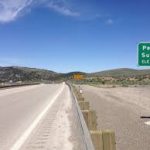
Travel lanes of Interstate 80 have been shifted in the Pequop Summit area between Wells and West Wendover as the Nevada Department of Transportation continues construction of two safety crossings. The two overpasses are designed to reduce the chance of vehicle-animal collisions by carrying deer and other animals over the interstate.
During daylight hours, I-80 traffic will be reduced to one lane in each direction and temporarily shifted to share designated lanes on one direction of interstate. Traffic lanes will be clearly marked and speed limits reduced for safety. The lane shifts will be in place daily through fall. Large vehicle loads over 16 feet in width are advised to take an alternate route.
The project, begun March 14, will construct two safety crossings; one of the east side and one on the west side of the summit. The crossings will span both directions of interstate, reaching approximately 200 feet in length and width. The wildlife overpasses will be covered with native soil and vegetation to replicate the natural environment and encourage crossing by deer and other animals. Deer fencing will be installed on both sides of the crossings to help direct animals to cross at the overpasses, avoiding potential traffic collisions.
NDOT and the Nevada Department of Wildlife partnered to identify the most critical deer migration and roadway crossings points at which to place the crossings. In recent years, one motorist death, twelve personal injuries and more than 200 wildlife-vehicle collisions have been reported to NDOT in the area, accounting for half of all wildlife-vehicle collisions along the entire length of I-80 in the state.
NDOT has also worked with NDOW to also install five safety crossings on U.S. 93 north of Wells. . Research conducted by the University of Nevada, Reno shows that, during the first four years in which safety crossings were installed, more than 35,000 mule deer used a safety crossing during their seasonal migrations; keeping them off the road and away from potential collisions with vehicles.
“These crossings are just one of the ways we work each day to help keep everyone safe and connected on Nevada roads,” NDOT Director Rudy Malfabon explained. “Ultimately, the most important factor is each person driving safely.”
SAFE WORK ZONE DRIVING TIPS
• Always buckle up.
• Pay attention. Normal speed limits may be reduced, traffic lanes may be changed and people and vehicles may be working near the road.
• Always slow to posted work zone speed limits.
• Remember that even if it may not seem that workers are present, work is still ongoing and speed limits must be observed.
• Continue to pay attention to work zone signs, even in areas of long-term road work.
• Remain calm. Remember that work zones are not there to inconvenience you- they are necessary to improve the roadway.
